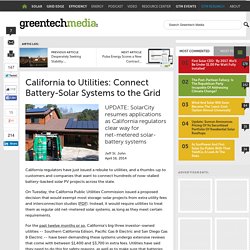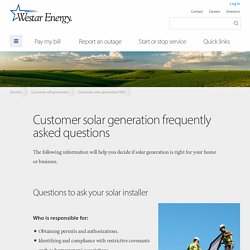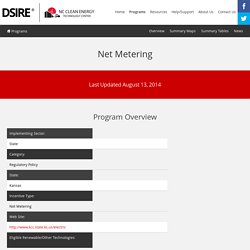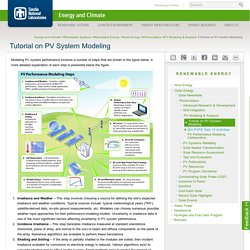

Dewight Traina
I want to live forever, adding value to the world we live in and find true happiness. I am a professional drummer. I am a recording studio engineer. I have a strong avionics/electrical background and experienced manager. www.trainastudios.com dewight@trainastudios.com
California regulators have just issued a rebuke to utilities, and a thumbs-up to customers and companies that want to connect hundreds of now-stalled battery-backed solar PV projects across the state.

On Tuesday, the California Public Utilities Commission issued a proposed decision that would exempt most storage-solar projects from extra utility fees and interconnection studies (PDF). Instead, it would require utilities to treat them as regular old net-metered solar systems, as long as they meet certain requirements. For the past twelve months or so, California’s big three investor-owned utilities -- Southern California Edison, Pacific Gas & Electric and San Diego Gas & Electric -- have been demanding these systems undergo extensive reviews that come with between $1,400 and $3,700 in extra fees. Utilities have said they need to do this for safety reasons, as well as to make sure that batteries don’t store grid power, then feed it back under the guise of green, net-metered power. Customer solar and wind generators – power your home or business by self-generation.
The following information will help you decide if solar generation is right for your home or business.

Questions to ask your solar installer Who is responsible for: Obtaining permits and authorizations. Identifying and compliance with restrictive covenants such as homeowners' associations. Satisfying applicable electric codes for existing wiring and new wiring. Take into consideration: How will I be notified when installers or inspectors need access to my home? Print - Questions to ask your solar installer Frequently asked questions Q. The two biggest factors are the amount of sunlight you get throughout the day and the amount of available space. Q. Generally, solar can be used to power your entire home's electrical systems, including lights, cooling systems and appliances. Q. Every home and business is different, so there are various system sizes.
Net metering application – customers with renewable electrical generating systems. DSIRE. Note: In April 2014 H.B. 2101 substantially modified Kansas’s net metering and interconnection rules, creating different rules for renewable energy systems beginning operation on or after July 1, 2014.

Kansas adopted the Net Metering and Easy Connection Act in May 2009, which established net metering for customers of investor-owned utilities (IOUs). Eligibility and Availability All IOUs in Kansas—Westar, Kansas City Power & Light, and the Empire Power District—are required to offer net metering, and some electric cooperatives have voluntarily created net metering provisions for their customers. IOUs are required to offer net metering on a first-come, first-served basis until the rated generating capacity of all net-metered systems equals 1% of the utility's peak demand during the previous year.
Net metering applies to systems that generate electricity using solar, wind, methane, biomass, or hydro resources, and to fuel cells using hydrogen produced by an eligible renewable technology. AltE: Solar Panels & Solar Energy Gear. System Advisor Model (SAM) DIY photovoltaics for all. Free Interactive Design Tools for Solar Power Energy Systems. Solar Mounting and Racking - IronRidge. SolarWorld - SW275MONOPROTCT, Monocrystalline, Solar Modules, Products, Solar/Clean Energy - Platt Electric Supply. National Laboratories: Tutorial on PV System Modeling. Modeling PV system performance involves a number of steps that are shown in the figure below.

A more detailed explanation of each step is presented below the figure. Irradiance and Weather – This step involves choosing a source for defining the site’s expected irradiance and weather conditions. Typical sources include: typical meteorological years (TMY), satellite-derived data, on-site ground measurements, etc. Modelers can choose numerous possible weather input approaches for their performance modeling studies. Uncertainty in irradiance data is one of the most significant factors affecting uncertainty in PV system performance.Incidence Irradiance – This step translates irradiance measured at standard orientations (horizontal, plane of array, and normal to the sun) to beam and diffuse components on the plane of the array.
Quick Mount PV: Respect The Roof - Quickest, Longest Lasting PV Solar Roof Mounts On The Market. Solar PV Monitoring.